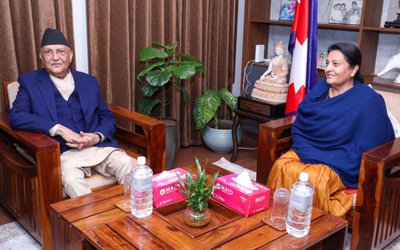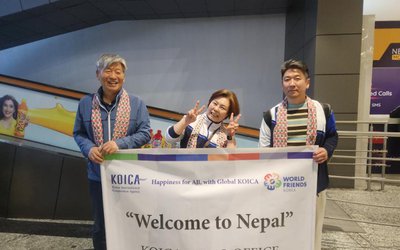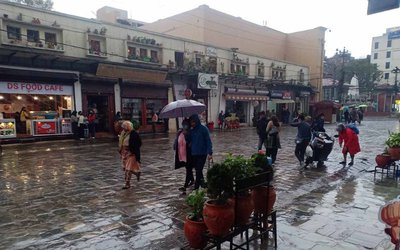The disability prevalence rate in Nepal is nearly 2% according to National Demographic Health Survey, 2011. It is nearly 1.7% when it comes to women. Disability is both a cause and a consequence of poverty, where persons with disabilities are not only economically disempowered, but socially and culturally disempowered and excluded.
Women and girls with disabilities face triple discrimination: by being female, having a disability and being amongst the poorest of the poor. They are often subjected to discrimination in accessing education, employment and health care and are at a greater risk of violence, injury, abuse, neglect or exploitation. They are often excluded from the social life of their communities and family. Women with disabilities are particularly disadvantaged due to the multiple forms of discrimination they experience. For example, disabled girls are the least prioritized in terms of access to school and education. Development activities such as income-generating programs for women are largely not accessible to women with disabilities and do not take active steps to include disabled women. Furthermore, girls and women who have a disability are more likely to become victims of physical and sexual abuse.
Approximately 15% of the population, nearly 1 billion people live with a disability. Of which, 80% live in developing countries- 19% of women and 12% of men. Various health related issues are leading to disability. People with a disability face many obstacles in their physical and social environments that prevent then from fully excising rights and participating in social, cultural and professional life as others in society do.
Women with disabilities have traditionally remained invisible in both disability and gender policies. Effective inclusion of women and girls with disabilities in development interventions requires specific strategies and mainstreaming strategies, often referred to as a twin track approach.
Women with Disabilities and their SRHR
Last week I met one of my friend who is also person with disability and she shared her experience on the assumption that disabled women are asexual. This has led women with disabilities a barrier to access reproductive health care, contraception, and sexuality information and social resistance to reproduction and mothering. Disabled women are at risk for a range of undesirable outcomes, including coercive sterilization. This remains me that persons with disabilities have the same sexual and reproductive health needs as other people. Yet they often face barriers to information and services. The ignorance and attitudes of society and individuals, including health care providers, raise most of these barriers, not the disabilities themselves.
Talking to her I remember an incident when I was traveling to Jumla. I met a mother of mentally retarded girl. Her concern was safety of her daughter. At home there is no one for her daughter to look after her 24 hours. She came to the headquarter of Jumla to inquiry about the female sterilization service to a girl with disability.
The interim constitution of Nepal ensures equality, freedom, justice and dignity of all individuals and implicitly mandates an inclusive society for all including persons with disabilities.
The persons with disabilities are often overlooked or neglected. Many persons with disabilities are marginalized, they are deprived of freedom, and their human rights are violated. Persons with disabilities have been denied information about sexual and reproductive health. Furthermore, they have often been denied the right to establish relationships and to decide whether, when, and with whom to have a family. Many have been subjected to forced sterilizations, forced abortions or forced marriages. In crisis situations these risks are multiplied.
It is hard to estimate the exact number of persons with disabilities who are affected by the earthquake or died in Nepal by the 25th April’s earthquake since there is no any system with government or any other agencies to track disability specific data at the time of emergency and post emergency situation.
National Federation of the Disabled Nepal (NFDN), in coordination with its member organizations, has started collecting data of persons with disabilities who are affected by earthquake and have lost their lives. But due to the heavy destruction caused by disaster in district and lack of resource the data collection is getting a bit slow. So far, NFDN has updated the information of 1000 persons with disabilities. 930 out of that are affected in different ways and 30 have been killed. As per the information updated from different districts, the affected persons with disabilities are living on the following condition in the post quake situation.
Violence against persons with disabilities is intermingled by the fact that the victims may be physically or financially dependent on those who abuse them. When they come forward to report such abuse, the medical, legal and social service system are often unresponsive and inaccessible. They face many barriers to care and information about SRHR, GBV and abuse. There is a myth regarding persons with disabilities that they might not be sexually active has reinforce the obstacle toward accessing SRH services. However, research shows, the persons with disabilities are as sexually active a persons without disabilities. SRH services are often inaccessible to persons with disabilities for many reasons, including physical barriers, the lack of disability-related clinical services, and stigma and discrimination.
Attitudes of people differ from place to place and among different types of disability. The great majority of persons with disabilities face prejudice and stigma in their daily lives. Parents of children with disabilities often find themselves socially isolated. Stigma, poverty and lack of support systems take a toll on such families.
The most effective way to advocate for women with disabilities and their access to SRH services is to establish a dialogue with local organizations of and for persons with disabilities and other organizations working on behalf of persons with disabilities. “Nothing about us without us” is a key principle among persons with disabilities. The Convention on the Rights of Persons with Disabilities reflects this principle. It underscores the importance of including persons with disabilities at all stages of policy development, program planning, and implementation. Too often, persons with disabilities and organizations of persons with disabilities are consulted only after a policy or program has been designed. Persons with disabilities must be more than just recipients of SRH programs and resources. Policies and programs at all levels are consistently better when organizations of persons with disabilities take part in planning from the outset.
Bazracharya is aYouth Champion- Nepal Asia Safe Abortion Partnership
- Sustainable Development Goals and Safe Abortion
- Oct 04, 2016
- Sustainable Development Goals and Safe Abortion
- Sep 13, 2016
- Kumari: A FeministThrough Gender Lens and Feminism
- Sep 06, 2016
















